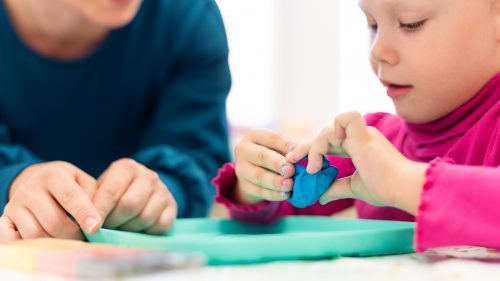Therapy Services
 Trauma-informed therapy services are offered to every child and their non-offending caregiver seen at Child Safe. We want children and families to know there is hope. There is a better tomorrow. Child Safe provides the opportunity for children and their families to have trauma-informed therapy, free of charge, in a safe non-threatening environment.
Trauma-informed therapy services are offered to every child and their non-offending caregiver seen at Child Safe. We want children and families to know there is hope. There is a better tomorrow. Child Safe provides the opportunity for children and their families to have trauma-informed therapy, free of charge, in a safe non-threatening environment.
Child Safe’s therapists are committed to supporting and empowering children to find their voice. Not only does Child Safe have forensic interviewers, advocates, and therapists, but because of the CAC model, we have an entire team providing resources and support.
Therapy Process
The forensic interview is a separate process from mental health treatment. And while the investigation is an important process, the therapeutic process focuses on providing a safe environment where the client can learn to trust again, begin to heal and find hope in the future.
While the forensic interview is a separate process from mental health treatment, Child Safe therapists do participate in the Multi-Disciplinary Team (MDT) process by attending case reviews. This allows for the child’s treatment needs to be assessed and the child’s mental health to be monitored and taken into account as the MDT makes decisions about the case.
Without effective therapeutic intervention, many traumatized children will suffer ongoing or long term adverse social, emotional, and developmental outcomes that may have an impact throughout their lifetime. Our Child Safe therapists are TF-CBT and EMDR trained and provide individual and family therapy. The therapy department also utilizes:
- Play therapy techniques
- Sandtray techniques
- Trauma assessments
- Court preparation and support
- Expressive techniques
- Safety planning
- Crisis support
Trauma Focused Cognitive Behavioral Therapy (TF-CBT)
TF-CBT is designed for children and adolescents between the ages of 3-18, and it is designed to reduce the symptoms of trauma in a step-by-step process. An overview of these steps includes educating the child and caregiver about the effects of trauma, teaching skills for stress management, learning to work through difficult thoughts and feelings related to the trauma, and gradually working through memories of the traumatic event(s). Sessions include individual time with the child, individual time with the caregiver, and joint sessions where the child and caregiver meet together with the therapist.
Eye Movement Desensitization and Reprocessing (EMDR)
EMDR is a treatment that allows people to heal from the symptoms of emotional distress that are the result of disturbing life experiences. EMDR is a process that, through bilateral stimulation, allows the individual to lessen the intensity of negative feelings and in turn enables the natural healing processes. This process is done through detailed protocol and can be used with children and into adulthood.
Play Therapy
Play therapy is a fundamental technique in which therapists use specific toys and activities to allow children to work through their problems and issues. In play therapy, it is said that “play is the children’s language and the toys are their words.” Observation of a child’s play shows the therapist any patterns of emotional dysregulation or chaotic events that may exist in a child’s world. In much the same way that an adult goes to therapy and talks through traumatic events, a child will come into a session and act out (non-verbally) the trauma he has experienced.
There are basically two types of play therapy: directive and non-directive. Directive play therapy is when an activity or game is planned specifically for the purpose of working through an issue and is used most often with adolescents and teens. Non-directive play therapy is when the therapist assumes a non-authoritative role in session and allows the child to navigate the room, toys and entire session at their own pace. This allows the therapist to observe behavior, support emotional regulation, and obtain a glimpse into the life of the child without fear of judgment or reprisal.
By using toys and techniques such as role-playing, puppets, sand tray, and board games that have been re-designed to have therapeutic benefits the children are encouraged to work toward their own solutions to problems and obtain a better understanding of how to handle their emotions. The biggest advantage of play therapy is that it works for children of all ages!
